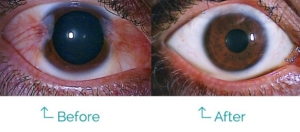
Pterygium, also known as “surfer’s eye,” is a non-cancerous thickening of the outer coating (conjunctiva) of the eye that grows onto the cornea. Normally the conjunctiva is a thin clear membrane over the ‘whites’ of the eye (sclera) and extends to the inner surface of the eyelids.
In most cases, pterygium must be surgically removed to relieve discomfort and restore the cosmetic appearance to the eye. Pterygium removal is a safe procedure and can be performed in our state-of-the-art office surgical suite.
How can you lower the chance of recurrence or regrowth?
The best way to lower the chance of recurrence or regrowth of a pterygium is to ensure you choose the best surgeon based on his or her experience and one that specializes in that procedure, has developed and continually improving a surgical technique, and has performed a large volume or large number of surgeries. When surgeons perform certain procedures with regularity and they specialize in those procedures, they continually improve and perfect their technique and are better equipped to deal with any complication.
Why Pterygium | Carnosidad Regrowth Occurs
Recurrence rates vary widely among current studies on pterygium regrowth. While some studies have reported rates as high as almost 40 percent, others report rates as low as 5 percent. Other studies have found that recurrence is higher among individuals who had their pterygium removed during the summer months, possibly because overexposure to the sun has been linked to pterygium development. Wearing polarized sunglasses is a must. Other factors that can increase the risk of recurrence include dusty and windy conditions.
One of the Lowest Documented Recurrence Rates in the World – The EyeWhite Institute at Visionary Eye Doctors
Dr. J. Alberto Martinez, Founder of Visionary Eye Doctors and one of the most sought after Pterygium surgeons in the world, has many years of collective experience, training and has developed The ASAP™ (Advanced Sutureless Amniotic Membrane Pterygiectomy procedure – providing a superior cosmetic outcome. Dr. Martinez, founder of The EyeWhite Pterygium and Pinguecula Research Institute has conducted numerous clinical research studies and has published in prestigious ophthalmology journals. He is on the cutting edge of the latest and most advanced surgical methods to reduce the possibility of recurrence, including using a special no stich, amniotic membrane technique.
Studies have shown this technique can lower pterygium recurrence rate to less than 5 percent. Dr. Martinez has one of the lowest recurrence rates in the world – less than 0.1%. Following your procedure, our team will schedule follow-up appointments with you to monitor your progress. We will also make recommendations on medications or steps you can take to minimize the chances of recurrence.
To learn more about the ASAP™ procedure, please click here.
LEARN MORE FROM VISIONARY EYE DOCTORS
To learn more about pterygium surgery or to schedule a FREE consultation, please request to schedule a surgical consult online today here, or call 301.896.0890 and a member of our team will gladly assist you.

Common Causes for Dry Eye Syndrome | Dry & Itchy Eyes Cause
/in Uncategorized /by Carolina ClavijoCan a Pterygium | Carnosidad Grow Back After Removal?
/in Uncategorized /by Carolina ClavijoPterygium, also known as “surfer’s eye,” is a non-cancerous thickening of the outer coating (conjunctiva) of the eye that grows onto the cornea. Normally the conjunctiva is a thin clear membrane over the ‘whites’ of the eye (sclera) and extends to the inner surface of the eyelids.
In most cases, pterygium must be surgically removed to relieve discomfort and restore the cosmetic appearance to the eye. Pterygium removal is a safe procedure and can be performed in our state-of-the-art office surgical suite.
How can you lower the chance of recurrence or regrowth?
The best way to lower the chance of recurrence or regrowth of a pterygium is to ensure you choose the best surgeon based on his or her experience and one that specializes in that procedure, has developed and continually improving a surgical technique, and has performed a large volume or large number of surgeries. When surgeons perform certain procedures with regularity and they specialize in those procedures, they continually improve and perfect their technique and are better equipped to deal with any complication.
Why Pterygium | Carnosidad Regrowth Occurs
Recurrence rates vary widely among current studies on pterygium regrowth. While some studies have reported rates as high as almost 40 percent, others report rates as low as 5 percent. Other studies have found that recurrence is higher among individuals who had their pterygium removed during the summer months, possibly because overexposure to the sun has been linked to pterygium development. Wearing polarized sunglasses is a must. Other factors that can increase the risk of recurrence include dusty and windy conditions.
One of the Lowest Documented Recurrence Rates in the World – The EyeWhite Institute at Visionary Eye Doctors
Dr. J. Alberto Martinez, Founder of Visionary Eye Doctors and one of the most sought after Pterygium surgeons in the world, has many years of collective experience, training and has developed The ASAP™ (Advanced Sutureless Amniotic Membrane Pterygiectomy procedure – providing a superior cosmetic outcome. Dr. Martinez, founder of The EyeWhite Pterygium and Pinguecula Research Institute has conducted numerous clinical research studies and has published in prestigious ophthalmology journals. He is on the cutting edge of the latest and most advanced surgical methods to reduce the possibility of recurrence, including using a special no stich, amniotic membrane technique.
Studies have shown this technique can lower pterygium recurrence rate to less than 5 percent. Dr. Martinez has one of the lowest recurrence rates in the world – less than 0.1%. Following your procedure, our team will schedule follow-up appointments with you to monitor your progress. We will also make recommendations on medications or steps you can take to minimize the chances of recurrence.
To learn more about the ASAP™ procedure, please click here.
LEARN MORE FROM VISIONARY EYE DOCTORS
To learn more about pterygium surgery or to schedule a FREE consultation, please request to schedule a surgical consult online today here, or call 301.896.0890 and a member of our team will gladly assist you.
How to Protect Your Eyes from a Pterigión or Carnosidad?
/in Uncategorized /by Carolina ClavijoHow to protect your eyes from a Pterygium | Pterigión | Carnosidad?
Most people may have not heard of a pterygium, and you may be wondering what the heck a pterygium is? Pronounced (turr-idge-ee-um) it may be easier to remember it by its nickname, Surfer’s Eye.
Tell me more about Pterigión | Carnosidad…
A pterygium is a condition that affects individuals who are exposed to sunlight for long periods of time. Surfers are at higher risk for developing this condition because they spend long periods of time in the sunlight. They are also at higher risk due to the reflection of the sunlight on the surface of the water. A pterygium can affect people of all ages who have excessive exposure to UV rays or by living in a dry, dusty, windy environment and also you may be prone to pterygium due to your heredity.
Prevention and Treatment
A pterygium is a non-cancerous growth on the white part of the eye. It typically grows on the inner cornea of the eye, closer to the nose. It can obstruct your vision and cause it to become blurry. The most common symptoms of a pterygium are blurry vision and a burning or itching sensation in your eyes as well as:
People who live in sunny climates, work outside or are from countries that are close to or live near the equator have a higher risk of developing a pterygium. It is also more common among individuals between the ages of 20-40 and affects men more commonly than women.
As with many medical conditions, the best treatment for a pterygium is prevention (we know, we know… but keep reading!)
With Spring and Summer approaching and as a pterygium may be caused by prolonged exposure to UV rays, the best way to protect yourself is by protecting your eyes from potential sun damage:
Not only does Pterygium affect your eye health, it can cause you to struggle with your appearance and create self-esteem issues. We can help, if you have a pterygium or may know someone who does, please contact us or request to request to schedule a free consultation.
Schedule a Consultation Today
Is Having a Pterygium Dangerous?
/in Uncategorized /by markStudy Finds Pterygium may increase risk of Cutaneous Melanomas
A pterygium is a visible growth on the surface of the eye. It typically emerges as a triangular, soft-tissue growth from the corner of the eye, with a pink and fleshy appearance. This growth is the body’s way of trying to protect the eye from intense environments, such as high levels of sunlight, dust, sand or wind.
In general, pterygia (plural) are not dangerous. During the early stages of pterygium development, the main concern is cosmetic – they change the eye’s appearance – but there is no effect on vision. Symptoms in the early stages may include irritation, itching or burning. These can generally be managed with eye drops. Avoid further exposure to sunlight and wind to reduce the stimulus for it to grow larger. A small pterygium that has stopped growing is relatively harmless and may not need any further treatment. However, surgery is an option if you are worried about the cosmetic appearance of your eye and find you feel self-conscious which may affect your overall confidence and social interactions.
In many cases, the pterygium may continue to grow across the eye and either directly block vision or distort the shape of the cornea and cause blurred vision (astigmatism).
Importantly, pterygia are not cancerous – they are benign growths. That means that while they may grow locally (and possibly affect your sight), they won’t spread to other parts of your body. Nevertheless, it’s important that you have an ophthalmologist evaluate any growth on your eye to rule out more serious conditions, such as a conjunctival or iris tumor.
Pterygium – a red flag for cutaneous melanoma, major new study shows
And while pterygia themselves are not cancerous, new findings published by Australian researchers, looked at 23,625 people who underwent treatment for pterygium, found that people who have a pterygium are nearly 25% more likely to develop malignant melanoma – a dangerous form of skin cancer.
The study advised, ‘Eye care providers who see patients with developing pterygia should advise these patients of this increased risk and recommend regular skin surveillance.” Tell your primary care or dermatologist if you have (or have had) a pterygium, make sure that you protect your skin from the sun/UV exposure (i.e. sunscreen, long-sleeved tops, shade) and always have regular skin checks.
Thinking of having your Pterygium removed?
/in Uncategorized /by markHow to select the best surgeon…
If you feel you would like to have a consult with a surgeon for your pterygium due to symptoms, vision issues and/or the overall appearance of your eyes, here are some essential considerations and questions you may wish to ask in order to receive the best possible medical or surgical treatment and care of your eyes:
Over the course of 30 years and more than 10,000 pterygiectomies, J. Alberto Martinez, MD has developed a surgical procedure for the removal of pterygium which he has honed and perfected with love and a passion over the years. The method, known as the A.S.A.P procedure (Advanced Sutureless Amniotic Membrane Pterygiectomy) has reduced the recurrence rate from 15% and above usually described in literature to 0.6%. Most importantly, the cosmetic appearance achieved after the A.S.A.P procedure is often so good, the patient tends to forget which eye had the surgery a few months later. Want to learn more? Please click here to schedule a Pterygium consultation.